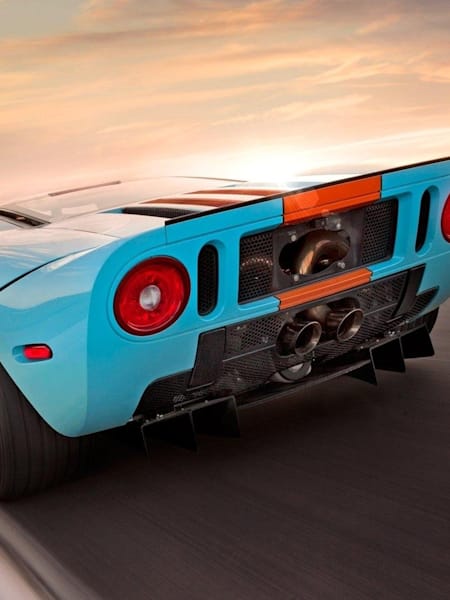When Nico Rosberg won the 2016 Formula One World Championship he essentially won the same thing Giuseppe Farina and every other F1 champ has won every year since 1950.
It might not seem like it sometimes, but Formula One has consistency — a tangible historical lineage. This is something the multi-class, multi-driver and multi-manufacturer world of GT racing doesn’t have.
The world of GT racing, or sportscar racing, is so confusing, but if you get your head around it, thou shalt be rewarded. Incredible cars, varied driving talent and a truly global, multi-national, multi-class extravaganza are on offer pretty much every weekend with races lasting between one and 24 hours and gracing circuits from the Nürburgring to Mount Panorama and Daytona to Spa.
Here's an overview:
1. It all started a long time ago
In the 1960s, cars like the Ford GT40 and a variety of Ferraris dominated the 24 Hours of Le Mans and these classic machines are to many what GT racing machines are all about. Or are they? Strictly speaking cars like the Sunbeam Alpine, AC Cobra or the Porsche 956B are proper GT cars because they competed in the GT class. The GT40 didn’t, it raced in the Prototype class at Le Mans.
To keep things simple and to quote commentator and sportscar racing expert David Addison: “GT racing is the recognizable equivalent to sportscars you’d see and recognize from the road. If you’ve heard of a Ferrari or Porsche, these are the race versions of them.”
2. But if you’re being a stickler, GT racing essentially started in the mid-1990s
"GT racing became the flagship sportscar class from about 1994 onwards with something called the BPR Global GT Championship," confirms Addison. “Since 1994 there's been a solid GT category throughout Europe and that has been largely because of Stéphane Ratel."
BPR Global was spearheaded by Porsche stalwart Jürgen Barth, flaxen-haired entreprenuer Stéphane Ratel and French event organizer Patrick Peter. It was a big hit. Grids full of Corvettes, Porsches and Ferraris graced the world’s premier circuits and it wasn’t long until the double-edged sword of manufacturer interest and money saw costs rising and regulation slackening.
This paved the way for the game changing McLaren F1 and the Mercedes CLK GTR to join the party and run away with all the silverware in the late 1990s.
3. It featured some amazing cars — but was hard to keep up with
Escalating costs and increasing manufacturer dominance from the likes of Porsche and Mercedes led to motorsport’s governing body the FIA wanting a slice of the pie.
Between 1997 and 2009, under the Stéphane Ratel Organisation (SRO), the FIA GT Championship brought together GT2 machinery spanning 911s, Lister Storms, Dodge Vipers and GT1 cars such as the daddy of them all, the 6.0L V12 Maserati MC12, which dominated the series from 2005 onward.
By 2010 GT2 was abandoned and GT1 continued, but its days were numbered, with Marc Basseng and Marcus Winkelhock winning the final FIA GT1 Championship in 2012 in, you guessed it, a Lamborghini.
4. GT3 to the rescue
Spiraling costs and manufacturer clout pushed up costs and led to GT3 being launched. The GT3 class was initially hatched in 2005 by the FIA and comprised of homologated machines based on road-going cars churning out around 600bhp — think Porsche 911 GT3, Aston Martin Vantage, Audi R8, Corvettes, BMW Z4s … that sort of thing.
"As costs escalated, GT2 was ignored and GT1 cars weren’t suitable for the likes of a 24-hour race at Spa, so GT3 cars joined the fray and that was where the idea of Blancpain came from," affirms Addison. "GT3 became so popular, interest in the GT1 series dissipated — GT3 was cheaper — the FIA GT Championship then became the Blancpain GT Sprint series, jettisoned the FIA tag and all associated expenses."
So, today, strictly speaking, GT racing spans the Blancpain Sprint and Endurance Cup (awarded since 2011) the WeatherTech Sportscar Championship in the U.S. and includes the European Le Mans Series and Asian Le Mans Series.
In the flagship World Endurance Championship, home of the 24 Hours of Le Mans, alongside the LMP1, LMP2 and GTE Pro and LMGT Am you'll find the stunning Ford GT40 — a le Mans winner and a direct link back to the earliest days of GT racing.
5. Still confused? Just watch the Bathurst 12 Hour
The 2017 Bathurst 12 Hours will see 15 or so cars battle it out for the outright win in GT3 Pro. The Bathurst 12 Hours is arguably emblematic of GT racing’s resurgence and forms part of a truly epic trilogy; the Intercontinental GT Challenge, which also takes in the 24 Hours of Spa and the Sepang 12 Hours in Malaysia.
This is where the likes of "Mr. Versatile" Shane Van Gisbergen, Jann Mardenborough and Aussie V8 legend Jamie Whincup will dice it out at high speed, halfway around the clock on the 6.2 km Mount Panorama circuit with the rest of the 50-plus car field made up of exotic machinery in GT Pro/Am, GT Am, GT4 and production saloons ensuring a depth of skill and speed levels that will make for some crazy thrills and manic spills.
Watch the Bathurst 12 Hour live, starting on Feb. 3










